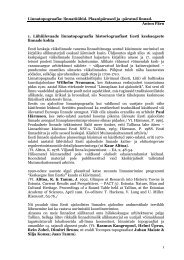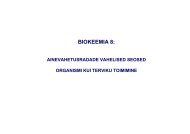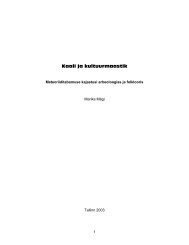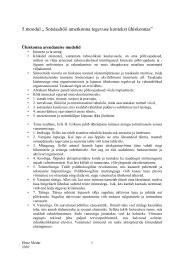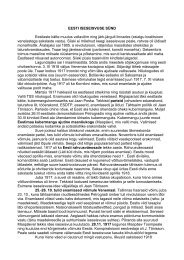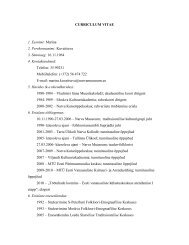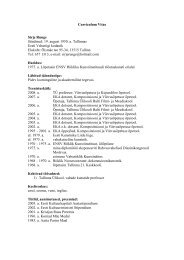crowding and children's mental health: the role of house type
crowding and children's mental health: the role of house type
crowding and children's mental health: the role of house type
You also want an ePaper? Increase the reach of your titles
YUMPU automatically turns print PDFs into web optimized ePapers that Google loves.
224 G. W. Evans et al.<br />
FIGURE 2. Photograph <strong>of</strong> typicalliving conditions in <strong>the</strong> lower Inn<br />
valley in Austria<br />
unrelated to social class (mo<strong>the</strong>r’s education or occupationalcategory).<br />
Figure 2 depicts a typicalcommunity<br />
in <strong>the</strong> area sampled <strong>and</strong> also illustrates<br />
generalliving conditions.<br />
Density was determined by dividing <strong>the</strong> number<br />
<strong>of</strong> people living in <strong>the</strong> residence by <strong>the</strong> number <strong>of</strong><br />
rooms in <strong>the</strong> home. Bathrooms, storage areas, garages,<br />
<strong>and</strong> hallways were not counted.<br />
Two measures <strong>of</strong> children’s psychological well<br />
being from <strong>the</strong> larger environment <strong>and</strong> <strong>health</strong> study<br />
are included here. All information was in German<br />
<strong>and</strong> collected by two experimenters (university students).<br />
The ¢rst measure consists <strong>of</strong> two subscales <strong>of</strong><br />
<strong>the</strong> KINDL (Bullinger et al., 1994) which is an index<br />
<strong>of</strong> quality <strong>of</strong> life designed for elementary-aged<br />
schoolchildren in Germany. Extensive psychometric<br />
documentation is available for this scale, including<br />
one week test, re-test reliabilities exceeding 0?90,<br />
measures <strong>of</strong> internalconsistency about 0?80, <strong>and</strong><br />
both convergent (e.g. midrange correlations between<br />
0?39 <strong>and</strong> 0?46 with severalo<strong>the</strong>r longer indices <strong>of</strong><br />
nonspeci¢c psychological <strong>health</strong> in children as described<br />
by <strong>the</strong> authors <strong>of</strong> <strong>the</strong> KINDLFsee below)<br />
<strong>and</strong> discriminant validity (e.g. children with high<br />
stressfullife events or those exposed to greater,<br />
chronic environ<strong>mental</strong>stressors manifest signi¢cantly<br />
lower KINDL scores). Fur<strong>the</strong>rmore, <strong>the</strong><br />
KINDL is unrelated to school <strong>type</strong> (private vs public)<br />
or speci¢c diseases (i.e. asthma vs diabetes) but<br />
is sensitive to children with <strong>and</strong> without chronic illness<br />
(Bullinger et al., 1994; Bullinger & Ravens-Sieberer,<br />
1995; Ravens-Sieberer & Bullinger, 1998). We<br />
combined <strong>the</strong> emotionalwe l-being scale <strong>and</strong> <strong>the</strong><br />
functionalimpairment scale because <strong>the</strong>y were<br />
highly correlated (r =0?63) <strong>and</strong> formed an internally<br />
consistent scale (a = 0?81). Fur<strong>the</strong>rmore, our<br />
data closely match subscale intercorrelations for<br />
<strong>the</strong> KINDL as reported by Bullinger <strong>and</strong> colleagues<br />
(e.g. 0?64^0?67). Scores ranged from 0 = never, 1 =<br />
rarely, 2 = sometimes, 3 = <strong>of</strong>ten to 4 = very <strong>of</strong>ten,<br />
with a higher score indicating higher quality <strong>of</strong> life.<br />
Children were administered <strong>the</strong> KINDL in writing<br />
in <strong>the</strong>ir own classroom with careful supervision to<br />
insure that each child responded independently to<br />
<strong>the</strong> questionnaire.<br />
The second scale was given to each child’s teacher<br />
<strong>and</strong> consisted <strong>of</strong> 11 yes/no questions about behavioralconduct<br />
in <strong>the</strong> classroom. This scale was originally<br />
developed by Needleman to measure classroom<br />
behaviors in relation to low-level ambient lead exposure<br />
in elementary school children (Needleman et al.,<br />
1979; Needleman, 1983). The scale has been shown to<br />
be sensitive to very small changes in lead levels both<br />
cross sectionally (Needleman et al., 1979; Yule et al.,<br />
1981; Needleman, 1983; Winneke et al., 1990) <strong>and</strong><br />
longitudinally from elementary school to high school<br />
(Needleman et al., 1990). The Winneke study included<br />
primary schoolsamples from eight European countries,<br />
including Germany. The 11 item scale was reliable<br />
(a =0?80). No prior data on scale reliability are<br />
available. Higher scores indicated better functioning<br />
in <strong>the</strong> classroom. The compiled items from both<br />
scales are included in <strong>the</strong> Appendix 1 .<br />
Both teachers <strong>and</strong> experimenters were blind to<br />
<strong>the</strong> child’s home density levels <strong>and</strong> <strong>house</strong> <strong>type</strong> at<br />
<strong>the</strong> time <strong>of</strong> data collection. Children were informed<br />
that this was a study <strong>of</strong> tra⁄c, environment, <strong>and</strong><br />
<strong>health</strong>.<br />
Results<br />
Table 1 provides descriptive data <strong>and</strong> <strong>the</strong> intercorrelations<br />
among <strong>the</strong> two scales <strong>and</strong> <strong>the</strong> two subscales<br />
<strong>of</strong> <strong>the</strong> KINDL. These data indicate, as would be expected<br />
given our sample <strong>of</strong> working <strong>and</strong> middle<br />
class children, that overall levels <strong>of</strong> psychological<br />
distress as well as behavioral conduct problems are<br />
quite modest. The absolute levels are also comparable<br />
to those found for <strong>the</strong> KINDL with nonclinical<br />
samples <strong>of</strong> similar age (Bullinger et al., 1994; Bullinger<br />
& Ravens-Sieberer, 1995; Ravens-Sieberer & Bullinger,<br />
1998) Because Needleman <strong>and</strong> o<strong>the</strong>r<br />
investigators have used <strong>the</strong> Teacher Behavioral<br />
Questionnaire with younger children, we cannot directly<br />
compare our data to prior information on <strong>the</strong><br />
(Table 2).<br />
Figure 3 depicts <strong>the</strong> KINDL, psychological <strong>health</strong><br />
regression results. Plots are shown for <strong>the</strong> mean


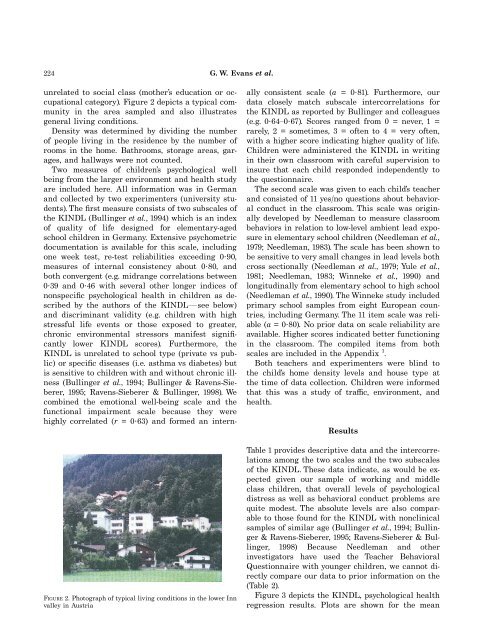
![5 Verben 2 S[1]. 35-44.pdf](https://img.yumpu.com/27096544/1/184x260/5-verben-2-s1-35-44pdf.jpg?quality=85)

